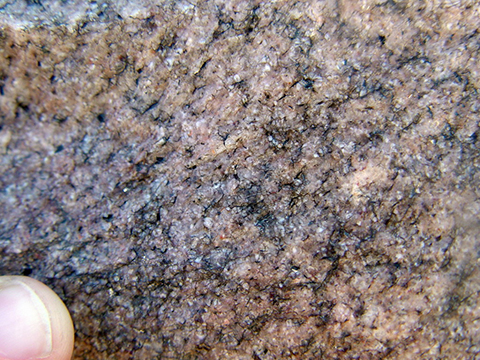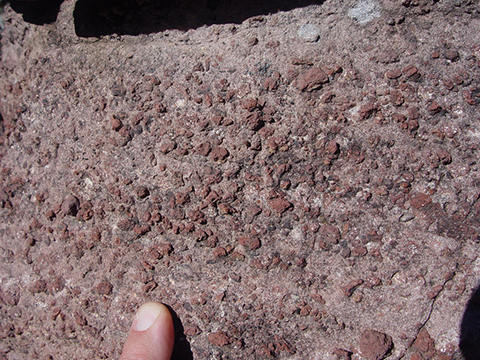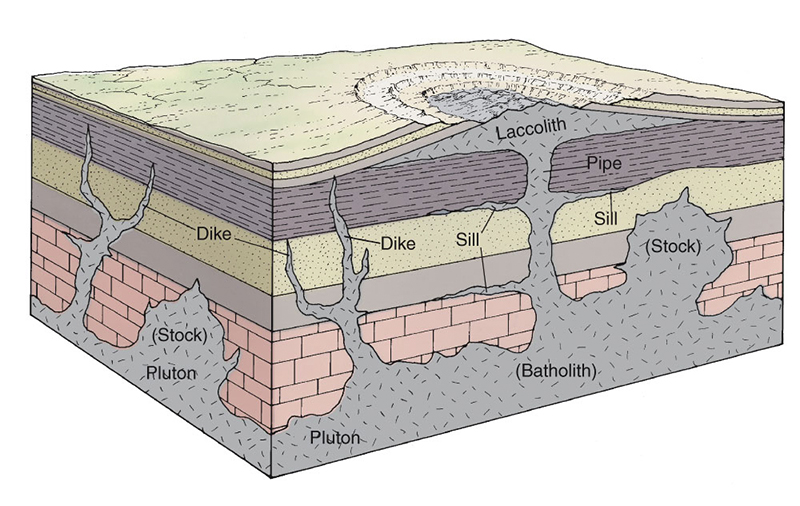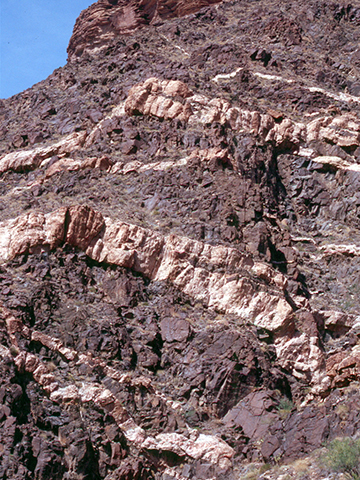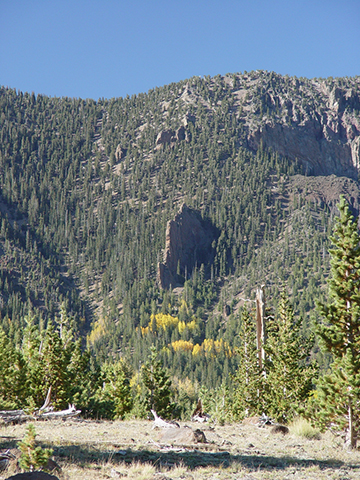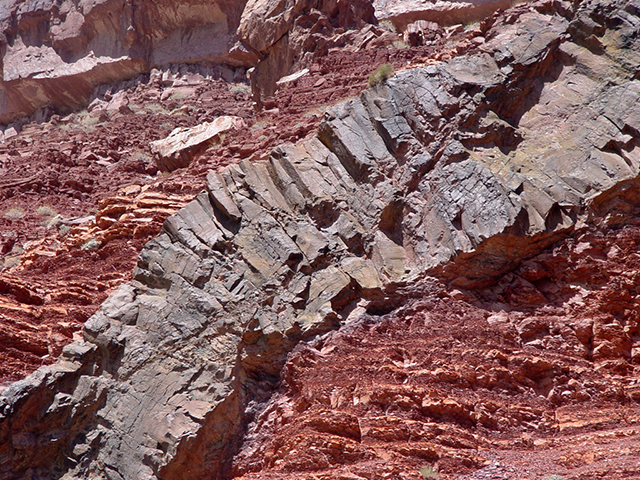Part B
Identifying & Interpreting Igneous Rocks and Structures
This is what it's all about: identifying rocks! Especially in the field, whether it's on a hike in the Grand Canyon, biking in the mountains, or just around the house (see Figure 4-6). Once you've learned the basics, you will get pretty good at identifying these rocks for yourself!
|
Figure 4-6. Identifying plutonic and volcanic igneous rocks in the field. Dated at 1840 Ma, the Elves Chasm Granodiorite (left) is the oldest known rock in Arizona. At right is a much younger lapilli tuff with an age of 15-20 Ma. |
|
Descriptions of Common Igneous Rocks
Let's review some of the common plutonic and volcanic rock types. There are a multitude of other important igneous rocks, with many are being slight variants of the main rock types.
Intrusive (Plutonic) Rocks
> A typically coarse-grained, light-colored rock that is felsic in composition (<15% dark minerals).
> Mineralogy - Composed primarily of the minerals quartz (gray and glassy), alkali feldspar (peach-colored to white), and plagioclase feldspar (white to light gray), with minor amounts (<15%) of dark-colored biotite.
> Leucocratic granite contains a very low amount of dark minerals. Granitic pegmatite is very coarse-grained rock found in dikes and is commonly rich in quartz, feldspar, and trace elements. Aplitic granite (aplite) is a fine-grained variant also found in dikes.
> Typically originates from melting of continental crust.
> Forms many types of intrusive igneous bodies (plutons), including large batholiths.
> Intrusive equivalent of rhyolite.
> Arizona examples - Camelback Granite (Phoenix), Komatke Granite (South Mountain), Dells Granite (Prescott).
> A coarse-grained, light- and dark-colored rock that is intermediate in composition (15-40% dark minerals).
> Mineralogy - Largely composed of amphibole (black) and plagioclase feldspar (white to gray) and has a higher abundance (15-40%) of dark-colored minerals than granite. The texture of diorite is commonly referred to as "salt and pepper" because of its black and white appearance.
> Commonly originates from subduction-related partial melting of oceanic and/or continental crust. May be associated with both felsic and mafic plutons.
> Intrusive equivalent of andesite.
> Arizona examples - Ruby pluton (Grand Canyon), Bland Quartz Diorite (central Arizona).
> A coarse-grained, dark-colored rock that is mafic in composition (40-90% dark minerals).
> Mineralogy - Primarily composed of large amounts (40-90%) of pyroxene (black or very dark green) and plagioclase feldspar (gray), with lesser amounts of olivine (green and glassy).
> Derived from partial melting of the mantle. Forms much the oceanic crust.
> Intrusive equivalent of basalt.
> Arizona examples - Gibson Creek Complex (near Payson), and many small, unnamed bodies across Arizona.
> A coarse-grained, dark-colored rock that is ultramafic in composition (>90% dark minerals).
> Mineralogy - Composed of large amounts (>90%) of olivine (>40%) and pyroxene.
> Forms much of the Earth's mantle and can partially melt to yield mafic magmas.
> Arizona examples - Nodules of peridotite can be found in some basaltic lava flows around Arizona, including in the San Bernardino Valley and near San Carlos.
Extrusive (Volcanic) Rocks
> A fine-grained to porphyritic, light-colored rock that is felsic in composition.
> Mineralogy - Typically contains quartz, alkali feldspar, and plagioclase feldspar, with minor amounts of biotite.
> Dacite is compositionally between andesite and rhyolite, and has more quartz than andesite and more plagioclase feldspar than rhyolite.
> Geochemistry - >63 wt% SiO2.
> Originates from the melting of continental crust.
> Highly viscous lavas form short, thick flows and steep-sided lava domes . May include explosive eruptions.
> Extrusive equivalent of granite. Dacite is the extrusive equivalent of granodiorite.
> Arizona examples - Superstition Mountains (near Phoenix); Chiricahua Mountains (southeastern Arizona), Kofa Mountains (southwestern Arizona); San Francisco volcanic field (near Flagstaff).
> A fine-grained to porphyritic, light- to gray-colored rock that is intermediate in composition.
> Mineralogy - Typically contains plagioclase and amphibole phenocrysts.
> Geochemistry - 52-63 wt% SiO2.
> Basaltic andesite is compositionally between basalt and andesite and has higher SiO2 (52-57 wt%) than basalt.
> Forms from hydrous melting of oceanic and/or continental crust, magma mixing, etc.
> Fairly viscous lavas that can be water-rich, helping to produce explosive eruptions of ash and lava that form steep-sided composite volcanoes (stratovolcanoes).
> Extrusive equivalent of diorite.
> Arizona examples - Tempe Butte (on the ASU campus); San Francisco Mountain (north of Flagstaff).
> A dark-colored rock that is mafic in composition.
> Mineralogy - Commonly contains olivine, pyroxene, and plagioclase feldspar.
> Geochemistry - 45-52 wt% SiO2.
> Basalt having 5-30% vesicles is called vesicular basalt, whereas basalt with >30% vesicles is termed scoria.
> Originates from the partial melting of ultramafic mantle rocks.
> Highly fluid lavas that erupt in a passive manner, forming lava flows, shield volcanoes , and cinder cones.
> Extrusive equivalent of gabbro.
> Arizona examples - San Francisco volcanic field (northern Arizona), Uinkaret volcanic field (NW Arizona); Perry Mesa (along I-17 in central Arizona), Sentinel volcanic field (along I-8 in SW Arizona).
Volcanic Glass & Obsidian![]()
> Dark-colored (either black or reddish brown) volcanic glass.
> Forms when lava is quenched (very suddenly cooled) and there is no time for crystals to form.
> Volcanic glass can have any composition. Obsidian is felsic, with its dark color from elemental impurities & lack of microscopic bubbles. Alters over time (changes color, cracks).
> Arizona examples - Locally exposed in felsic volcanic fields; Picketpost Mountain (near Superior).
> A dark-colored (reddish to black), fine-grained to glassy rock with a vesicular texture (>30% vesicles).
> Forms from gas-rich mafic lava. As magma rises to the surface, gas bubbles grow and try to escape as the magma/lava solidifies.
> Unlike pumice, scoria will typically sink in water because of its higher density.
> Arizona examples - Scoria is common in mafic volcanic fields where cinder cones are abundant (San Francisco volcanic field).
> A light-colored, frothy, volcanic glass that is extremely vesicular.
> Forms from gas-rich felsic to intermediate lava. As magma rises to the surface, gas bubbles grow and try to escape as the magma/lava solidifies.
> Pumice can actually float in water due to its low average density (from all the air pockets within it).
> Arizona examples - Pumice deposits are also locally exposed in the northern San Francisco volcanic field.
Pyroclastic Rocks (Agglomerate, Pyroclastic Breccia, Lapilli Tuff, Ash Tuff)![]()
> Pyroclastic rocks are made of pieces where the size of the pieces can vary from ash-sized (very small) to large blocks and bombs (meters in diameter).
> Tuff is a word generally used to describe fine-grained airfall material (tephra).
> Ash tuff is a fine-grained pyroclastic rock where the average size of pyroclastic particles is ash-sized (<2 mm). Ash tuff may be massive or well-bedded, and can be transformed by high-temperatures after deposition into more resistant welded tuff.
> Lapilli tuff is a pyroclastic rock where the average size of pyroclastic particles is gravel-sized (2 mm to 64 mm).
> Pyroclastic breccia is a coarse-grained pyroclastic rock where large angular clasts are boulder-sized or bigger (>64 mm).
> Agglomerate is formed from molten to partially molten airfall material (spatter, volcanic bombs) that typically welds together along the rims of volcanic vents.
> Pieces can include solidified lava, as well as rock fragments accidentally caught in the eruption.
> Pyroclastic rocks are formed in a wide range of volcanic eruptions. The smaller the fragments, the more violent the eruption.
> Arizona examples - Peach Springs Tuff (northern Arizona); felsic volcanic fields (Superstition, Chiricahua, etc.).
Igneous Rock Identification
The most common identification procedure for igneous rocks (both plutonic and volcanic) involves observing the size and arrangement (texture) of the various types of mineral crystals (composition) in the rock. Most commonly, we make a visual determination of a rock's texture, combined with a somewhat subjective judgment of the composition. Plutonic rocks generally have large crystals arranged in a few different textures. For these rocks, we have only to identify the minerals and their relative abundances in the rock. Volcanic rocks possess more textural varieties, but most of them are fairly easy to identify. However, the individual mineral crystals are commonly too small to identify, so the mineralogy (and thus, composition) is inferred from the rock color, although color is not always representative of composition. This qualitative field classification is the approach we typically use to identify rocks in this course. Much of this information is shown in the igneous rock classification chart in Figure 4-7.
|
Figure 4-7. A rock identification chart for common igneous rocks. Click HERE for a printable PDF version. |
* IMPORTANT *
Using the PDF link above, print a hard-copy version of this chart for use in this lab and the lab quiz.
If a more quantitative approach is required, we can study thin sections of the rock under a petrographic microscope (petrography). We can even have a chemical or isotopic analysis performed to determine the abundances of certain elements (like Si, Fe, Mg, etc.). Knowledge of a rock's geochemistry is very helpful, not only in classifying these rocks, but in describing their nature and origin. For instance, determining the silica content (weight % SiO2) of an igneous rock is important for several reasons:
Classification - Igneous rocks can be named according to their geochemistry, including weight% SiO2 .
How Magma Erupts and Flows - In general, the higher the wt% SiO2, the more viscous the magma . So SiO2-rich (>63 wt%) lavas are highly viscous and form short, thick flows and steep-sided lava domes, and violent eruptions occur due to the pressure of the trapped gases. SiO2-poor (<52 wt% SiO2) lavas are very fluid and flow for longer distances. These lavas erupt more passively, as the gas that drives an eruption can escape more easily.
Origin of the Magma - In general, SiO2-rich (felsic) magmas form from the melting of continental crust, whereas SiO2-poor (mafic) magmas form from partial melting of the mantle. Intermediate magmas form from the hydrous (water-rich) partial melting of oceanic and/or continental crust, mixing of mafic and felsic magmas, etc.
Let's now try our luck at identifying some of the common igneous rock types. Examine the texture and composition of the samples to answer questions B10 through B20. Refer to the Igneous Rock Identification Chart and the rock descriptions.
![]()
![]()
![]()
![]()
![]()
![]()
![]()
![]()
![]()
![]()
![]()
Plutonic Igneous Structures
Igneous structures are the various features and landforms created during intrusion or eruption. Volcanic structures include various types of eruptive landforms, like volcanoes, lava flows, ash flow sheets, etc., whereas plutonic structures form from the intrusion of magma (Figure 4-8).
Types of Plutons
We know from studying plutonic rocks that have been uplifted and exposed at the Earth's surface that magmas crystallize in various shapes called plutons (see Figure 4-8). We know from field and geophysical studies that plutons have various shapes, but we can also directly study these features after they have been uplifted and exposed at the surface, typically millions of years after the magma originally solidified. Plutons can be classified according to their size and shape, ranging from enormous batholiths to smaller, irregular stocks to thin sills and dikes (see Figure 4-9).
Pluton - A generic term for any intrusive igneous body.
Batholith - A very large intrusion (>100 km2) that usually consists of multiple plutons emplaced over thousands to millions of years.
Stock - An intrusion with irregular shape and much smaller than a batholith.
Sill - A tabular, sheet-like pluton that generally follows the layering in the surrounding rock. Typically emplaced at shallow crustal levels.
Dike - A thin intrusion that typically cuts across the layering in the surrounding rock. Typically emplaced at shallow crustal levels.
Laccolith - A shallow crustal intrusion injected between two layers of sedimentary rock, arching the overlying layers upward.
|
Figure 4-9. Intrusive igneous features in the field. Light-colored felsic dikes intrude darker diorite at Mile 107.2 on the Colorado River in the Grand Canyon (left), and a large dike in the Inner Basin of the San Francisco Peaks (right). |
|
Dating with Plutons
Plutonic structures can be very useful in establishing the relative ages of rocks in a geologic cross section or sequence diagram. The relative dating principles of cross-cutting relations and inclusions are very helpful determining the order of intrusions. Intrusions typically have "bake zones" or "contact aureoles" around their margins, where the surrounding rocks have been changed by the high temperatures and fluid activity of the intrusion. Plutonic rocks also may provide absolute age determinations if they have compositions suitable for isotopic dating.
|
Example 1 |
|
Is this intrusion a sill or a dike? |
|
Dike It cross-cuts the layering in the surrounding reddish rocks. |
